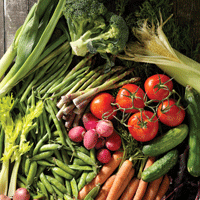The local food movement finds friends and supporters in Guelph, Ont.
In the small city of Guelph, Ont., surrounded by the fertile fields of Wellington County, the local food movement is alive and growing. In the past two months alone, residents have “romped” through county farms, learned how to grow mushrooms and organic vegetables and celebrated local food at festivals, feasts and restaurants.
At the centre of this culinary whirlwind is Kate Vsetula, a founding member and project coordinator for Guelph Wellington Local Food, launched in 2005 to support area producers and put healthy, locally grown food on more plates.
Along with a map highlighting where to find local food in the region, the group has created its own brand, “taste – real,” to help residents and visitors identify local food. Anyone growing or selling a certain percentage of local food can become a partner and use the brand. “The response has been phenomenal,” says Vsetula. “One exciting spinoff is the five major festivals in Guelph are now featuring local food,” she adds, “and the brand is showing up at farm gates, farmer’s markets and on restaurant menus.”
These days, Vsetula is also using her considerable experience and networking skills to bring more of the region’s bounty — from milk, cheese, apples and eggs to vegetables, meat and maple syrup — to the broader public sector. With the help of a grant from the Greenbelt Foundation, she and her team will be reaching out to 98 organizations, from daycare centres to government offices, tapping into a combined annual foodservice budget of $25 million.
The key to success is finding partners and champions, and the project coordinator is thrilled to have found a small army of both. For example, chef Neil Hannah of the bistro at Guelph General Hospital, crunched some numbers to prove just how affordable local food can be. He calculated, for example, that frozen U.S. burgers cost 77 cents a patty, while burgers made with fresh Ontario lean ground beef cost 75 cents a patty, including labour and ingredients.
To get people talking face to face and sharing ideas, Guelph Wellington Local Food organized a day of networking and discussions in February called “Source It Here.” In future sessions, chefs will also be encouraged to get together to discuss how they’re using local food and how they can use more.
While creating and streamlining distribution channels between local farms and customers remains the biggest challenge, the group has just created a wholesale volume map to assist area foodservice operators. “Everyone is pleased with our local food map, but a chef in a busy kitchen can’t decipher which farm can give him the volumes he needs on the day he needs them,” Vsetula says. “This tool will tell them what farms they can look to and who has cold storage. We’re trying to join all the dots together.”
When she looks at how much Guelph Wellington Local Food has accomplished, Vsetula is amazed. “It started as a sprout of an idea with a few local farmers and concerned citizens sitting around a table,” she says. “I’m excited about all the partnerships that are developing. We’re ready to forge ahead and make this work.”
For more information, visit guelphwellingtonlocalfood.ca





















